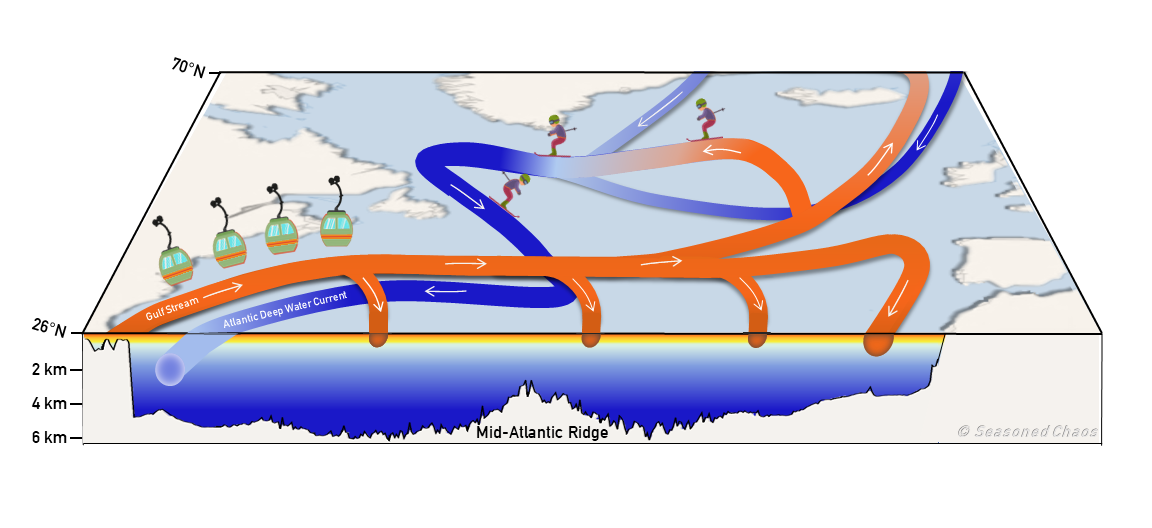AMOC Mountain Ski Resort
Since we are well into ski season let’s head to the mountains and learn about a critical component of the climate system: the Atlantic Meridional Overturning Circulation or AMOC. Just like the atmosphere has circulation patterns that carry heat from the equator to the poles, oceans have circulation patterns that transport heat as well. One of the largest transporters of heat is the AMOC, a system of warm northward flowing and cold southward flowing ocean currents.
Thermohaline Mountain Range
As we get ready for our day on the slopes let’s hit the breakfast buffet at the lodge and familiarize ourselves with the Seasoned Chaos AMOC Mountain Ski Resort. The resort is located within the Thermohaline Mountain Range (aka global ocean circulation). Often referred to as a “conveyor belt”, the thermohaline circulation is a slow-moving flow of water that transports heat and nutrients across the whole Earth. It is driven by density changes of the water caused by differences in temperature (thermo) and salinity (haline). It takes about 1,000 years for water to complete the cycle, just like it would take a long time to ski every trail on the mountain range.
Bunny Slopes to Black Diamonds
The main ski lift at AMOC mountain is the Gulf Stream. Just as the lift carries people (all sweaty bundled in their gear up to the top of the mountain) the AMOC begins with the Gulf Stream bringing warm surface waters along the east coast of the U.S. northward to high latitudes in the North Atlantic near Greenland, Iceland, and the North Sea. This warm surface water comes from the South Atlantic near Antarctica. As it travels north and crosses the equator, it heats up and gets saltier due to evaporation in the hot tropics. Once it reaches the cold polar region, some of the freshwater freezes into sea ice making the water even saltier. As the salty water cools it becomes denser than surrounding waters and begins to sink to the bottom of the ocean. This process is called North Atlantic Deep-Water formation (NADW) and it drives AMOC.
Check out this video showing the flow of water through the AMOC (plus the rest of the global thermohaline circulation)!
NADW returns south toward Antarctica through deep water currents or “ski trails”. Once we jump off the Gulf Stream lift there are many different trails to choose from but all end at the bottom of the mountain where you can get back on the lift and ski some more. With AMOC, the same thing happens! The deep cold water is then upwelled in the Southern Ocean due to strong winds around Antarctica and the cycle begins again.

A 3-D depiction of the Atlantic Meridional Overturning Circulation in the North Atlantic Ocean as a skiing excursion. Let’s shred!
Warming up at the Lodge
Our legs are getting tired from shredding down the mountain so let’s take a break and warm up by the fire. We are not the only thing that is warm though, since the AMOC carries so much heat from south to north, it can influence the climate. Northwestern European countries can have milder winters due to the constant influx of heat from the AMOC. This is why parts of the world that may be at the same latitude, like Newfoundland, Canada and Ireland, have different climates and why there is also little sea ice around southern Greenland and Iceland.
The AMOC can be used to predict the climate system too. It is a large source of decadal and multidecadal variability in the Atlantic Ocean changing sea surface temperatures SSTs across long time scales. Also, since the deep water does not encounter the air, it can hold onto heat and nutrients (ex. carbon dioxide) much longer than the atmosphere. Scientists say that because of this the ocean has a longer “memory” than the atmosphere providing a source of predictability for other weather and climate processes.
Forecasting at AMOC Mountain
Slow processes like the AMOC can affect sub-seasonal to seasonal forecasts (S2S) and lead to better long-term predictions. New studies are beginning to look at AMOC for its impacts on seasonal forecasts. My current research focuses on how the speed and position of our main lift, the Gulf Stream, has also been linked to increased coastal flooding which will affect many seaside communities and ecosystems.
AMOC can also influence North Atlantic hurricane formation. This is because of its ability to distribute SSTs in the Atlantic. As we have learned about before from our seasonal hurricane outlooks (here, here, and here) warmer SSTs can lead to hurricane development. Longer term predictions of Atlantic SSTs could help with hurricane seasonal forecasting. Possible links between a weaker AMOC causing higher SSTs in the Atlantic and an upward trend in hurricane development is an active area of research1.
Long Lines and Slow Lifts

Uh oh, the lift has slowed down… It’s a skier’s worst nightmare! The mountain is packed since there was just a snowstorm leaving a fresh pile of fluffy snow. Long lines mean a slower ride to the top. More people are like more heat in a warming climate, and a slow lift means less transport of people. Well, the same is true for the AMOC. Climate model projections from the Intergovernmental Panel on Climate Change (IPCC) suggest that AMOC is likely to weaken over the 21st century. Models forecast a decline of AMOC transport by 25% possibly creating a different climate in the North Atlantic than we see today2. As our atmosphere warms, more freshwater is being added due to precipitation and ice sheets melting. This could weaken the sinking of the cold salty water, meaning a slowdown of the AMOC. Without the AMOC, winters in northwest Europe could become significantly colder and SSTs in the Atlantic could become warmer affecting many climate processes around the globe. In the coming decades it will become increasingly important to monitor the strength of the AMOC and see how the climate is being impacted. But for now, enjoy your hot chocolate and warm your toes by the fire. It has been a long day on AMOC Mountain.
Footnotes:
1Duchez, A., Courtois, P., Harris, E., Josey, S. A., Kanzow, T., Marsh, R., … & Hirschi, J. J. M. (2016). Potential for seasonal prediction of Atlantic sea surface temperatures using the RAPID array at 26N. Climate Dynamics, 46, 3351-3370.
2IPCC AR6 Summary for Policy Makers